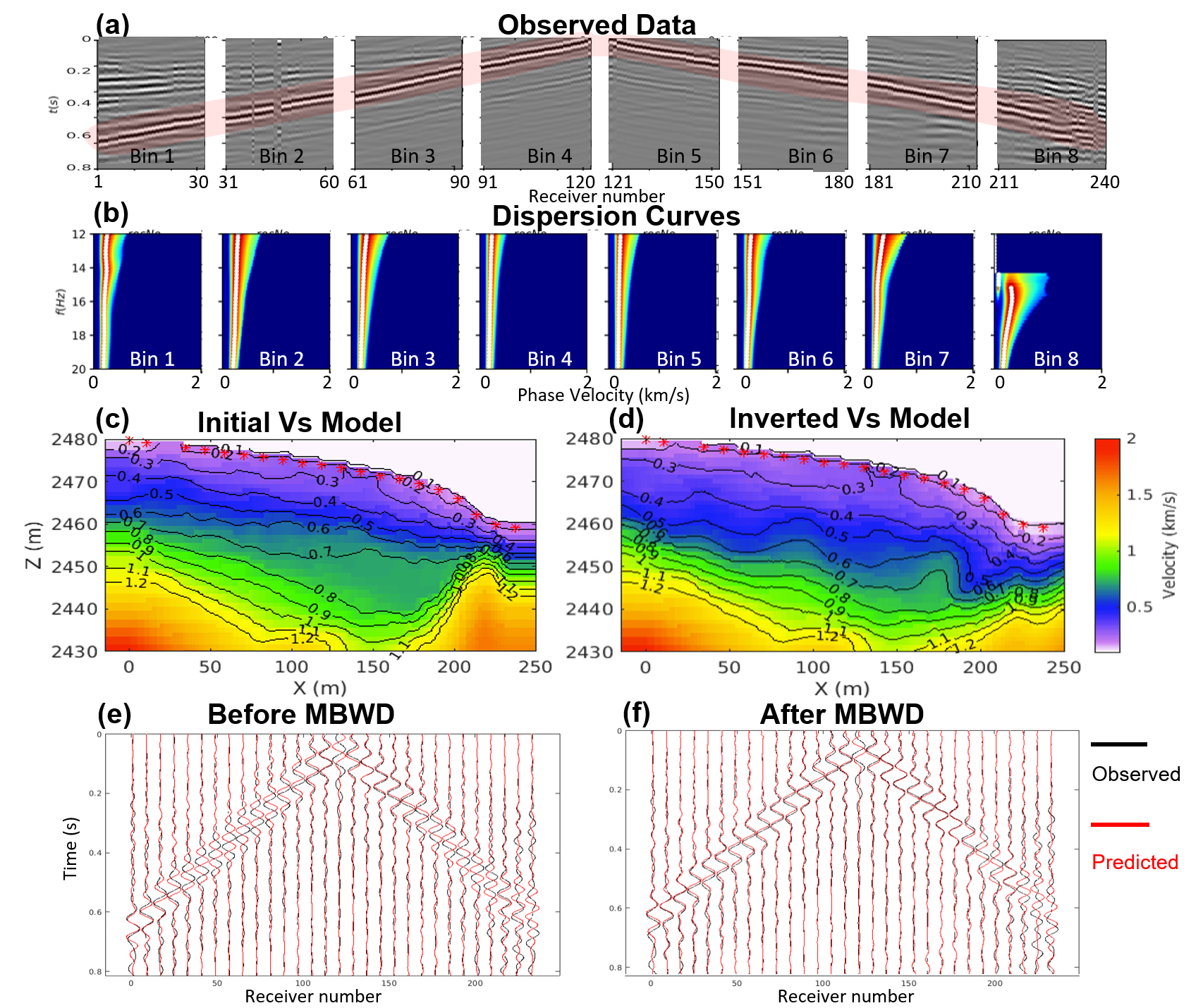Robust Multi-bin Wave Equation Dispersion Inversion Methods
for High-resolution Seismic Imaging of Near-surface Geology
- Zhaolun Liu Ocean University of China
- Yi Luo Cloudstream Medical Imaging Company
- Ben Eppinger Virginia Tech
Figure 1: An example demonstrating the effectiveness of our proposed multi-bin wave equation dispersion inversion (WD) method in inverting the shingling event.

Figure 2: A real data example of the multi-bin wave equation dispersion inver- sion method (MBWD) applied to surface wave inversion.

Objectives
Estimating the shallow wave speed model from land seismic data can be challenging due to the complexity of near-surface structures. When there is a significant velocity contrast or velocity reversal in the near-surface, the early arrivals at large offsets will be dominated by shingling events, while surface waves will dominate late arrivals at near offsets. It can be almost impossible to pick the first break of the shingling events, making traditional first-arrival tomography methods prone to failure. In response to this challenge, we propose a new, robust method that can invert shingling events and surface waves in an accurate and reliable manner.
Methods
I propose a robust multi-bin wave equation dispersion inversion (WD) method for inverting surface and shingling waves. The multi-bin WD method subsets data into receiver bins through spatial windowing. For each receiver bin, the method skeletonizes the complicated dispersive wave arrivals (e.g., shingling events and surface waves) into simpler data, namely the picked dispersion curves in the frequency-wavenumber (f-k) domain. The method then calculates the dispersion curve difference for each bin by maximizing the cross-correlation of the amplitude of the observed and synthetic f-k spectrum. The misfit function is determined by summing the squared differences between the wavenumbers along the predicted and observed dispersion curves. Model parameters are updated using the misfit gradient, which is calculated via an adjoint-state method.
Results
We demonstrate the effectiveness of our multi-bin WD algorithm by applying it to invert shingling events (see Fig. 1c) from a complex layered model (see Fig. 1a). The near-surface model inverted by multi-bin WD is close to the true model (see Fig. 1g), and the travel time, waveform, and dispersion curves of the synthetic data calculated from the inverted model by multi-bin WD match well with those from the observed model (see Figs. 1h-1i). In comparison, wave-equation traveltime inversion (WT, see Figs. 1d-1f) can only update the model (see Figs. 1d) to match the travel time of the data (see Fig. 1e), but the waveform and dispersion curves of the synthetic data from WT are still discrepant with the observed ones. Next, we apply multi-bin WD to invert surface waves for S-wave wave speed (VS) (see Fig. 2). The seismic data set is collected in Wyoming, US for the critical zone study (see Fig. 2a). Eight bins are used, and the corresponding dispersion curves are calculated (see Fig. 2b) and used to invert for the VS model. The initial and inverted VS model are shown in Figs. 2c and 2d. The waveform comparison before and after inversion is shown in Figs. 2e and 2f, respectively. We can see that the waveform matches very well after multi-bin inversion, even though our misfit is based on the dispersion curves. These results demonstrate the effectiveness of the multi-bin WD method.